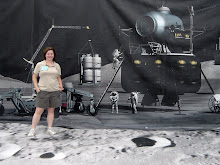It was a real treat to have a fellow MER scientist, proto-Dr. Shawn Wright from ASU (below, with me at the crater edge), join us there to show us some of the remote sensing he did of the crater. Shawn came fresh off field work looking at potential craters in South America and though tired, he was enthusiastic about guiding us to his favortite locations around the crater. At several stops, we could easily trace cliff outcrops and correlate specific ejecta lobes with remote sensing imagery because of Meteor Crater's unique (and fortuitous) target material: discrete layers of red siltstone, yellow limestone, and sugary white sandtone.


No comments:
Post a Comment